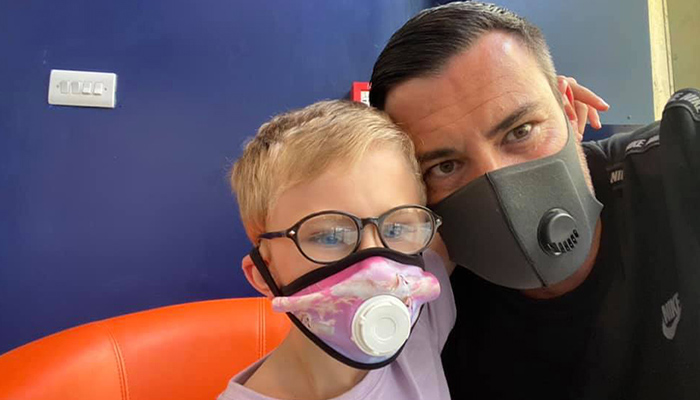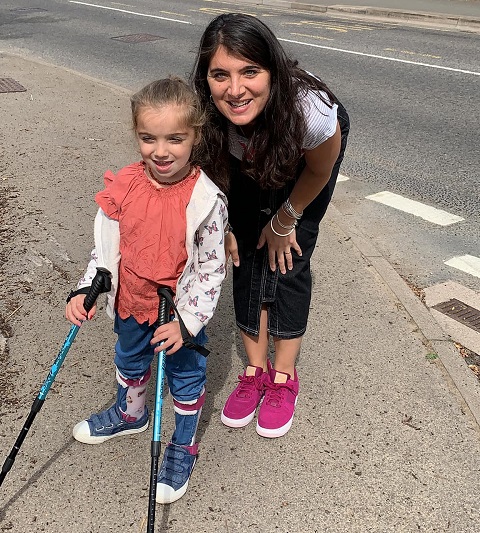
21 October 2020
Five-year-old Austin has a diagnosis of cerebral palsy and underwent SDR surgery in November 2018. In July 2020, Austin’s parents brought him to LOC’s OSKAR Clinic, hoping that we could help him to walk independently and with more confidence. The bespoke ankle foot orthotics (AFOs) that we prescribed resulted in immediately visible improvements. Now, four months on, the difference in Austin’s movement is incredible, according to his father, Bradley.
Austin was born in 2014 with his identical twin, Freddie. Both twins came along at just 25 weeks and spent the first four months of their lives in intensive care. For Austin, this resulted in a diagnosis of cerebral palsy at the age of 2½, setting him and his family on a challenging path.
“Austin is six now, and he has had a total of eight major surgeries,” Bradley explains. “In 2018, he underwent Selective Dorsal Rhizotomy, or SDR, surgery. It works by severing some of the spinal nerves to reduce spasticity. After the surgery, you essentially have to learn how to use your body all over again through an intensive and ongoing rehabilitation programme. With cerebral palsy, it’s impossible to say for sure what a child will to be able to achieve in the long term. So, as a family, we do absolutely everything we can to support Austin. We’ll move mountains to help him reach even the smallest milestone.”
That’s something of an understatement, given that the family has raised almost £50,000 to support Austin with the help of a registered charity, Just 4 Children. Happily, Austin met the criteria to receive the SDR surgery itself on the NHS at Great Ormond Street Hospital. That means that the funds raised are being used to support his post-surgery rehabilitation. “Austin has two to three physiotherapy sessions a week and we also organise swimming, horse riding and hydrotherapy. Plus, he has received a mix of privately funded and NHS splints to support him as he regains muscle strength,” Bradley says. “But he was still very unsteady and at home, he crawled most of the time. We thought how lovely it would be just to see him walking independently around the house with his twin brother.”
Austin’s family came into contact with little Lilac, another LOC patient who has undergone SDR surgery and followed an intensive course of orthotic treatment with astounding results. “When Lilac’s mum told me about the profound impact orthotics have had on Lilac’s movement, we felt we had to investigate further,” says Bradley. “So, we travelled to LOC’s Covid secure Kingston clinic in July to find out what might be possible.”
These videos, taken in LOC's gait laboratory, show the impact of Austin's orthotics on his balance, confidence and stability. He wears his old splints on the left and new AFOs in the clip on the right.

Above: Lilac with her new AFOs back in 2019
Sam Walmsley, Lead Orthotist at LOC, assessed Austin in LOC’s purpose-built gait laboratory. “It quickly became apparent that, although Austin could walk for short distances in his previous splints, he was very unsteady and unsure of his own stability,”
Sam explains. “There were several issues with his previous splints. They didn’t fit him well, they weren’t controlling the movement around his foot, his asymmetrical gait pattern had not been considered and he needed some orthotic adaptations to his shoes as well.
So, we took new casts and manufactured a bespoke set of AFOs to address these issues. We equalised his leg lengths within the prescription and created a more biomechanically accurate fit around his foot and ankle. The result was a pair of AFOs that are very snugly fitted and control his tendency to pronation extremely well. The right and left AFO were designed differently to control the specific gait problem on each leg.
We then customised a pair of normal trainers with a flat base and a slight wedge to achieve the correct shank to vertical angle. As soon as we fitted the new AFOs, Austin’s gait became more balanced. He showed more control and stability and a good alignment of his lower limbs. The AFOs generated the required forces to produce a normal gait pattern, this in turn will also help his bones and muscles grow and develop correctly.”
Austin’s treatment at LOC is being conducted within the OSKAR (Optimal Segmental Kinematics and Alignment Approach to Rehabilitation) framework.
This was originally developed in 2012 by our renowned physiotherapist, Elaine Owen, in partnership with LOC. The extensively evidenced framework operates within ICF guidelines. It aims to work with parents and health professionals to set, monitor and achieve individual goals for children with lower limb neuromuscular conditions.
Bradley tells us that this approach, coupled with LOC’s gait lab technology, has made all the difference for Austin. “Other orthotic clinics offer similar treatments,” he says, “But LOC’s video vector technology measures exactly where Austin’s weight is being distributed, how his hips are moving and how his legs are moving. It’s those insights that have made his new AFOs so effective. Even within a few days, LOC’s splints have had more impact on his independence of movement than anything else we have done. And the team is really supportive. They didn’t just ask us what our goals were for Austin, but also how we wanted to get there. In fact, as we have learnt more about what’s possible with orthotics, those goals have shifted. We spent years trying to work out how to get Austin out of splints completely, however it wasn’t until we met Sam that we realised that the most meaningful goal is for him to walk independently, even if he needs to continue wearing splints to do that.”
Four months on from that first appointment, Bradley tells us that progress is extremely encouraging. “Now, it’s the norm for Austin to just get up and walk around the house on his own. Next, we hope he’ll be doing the same outside with real confidence. For the first time ever the other day, he walked beside me for about forty minutes, with Freddie by his side. On the surface, there isn’t much difference between other orthotic providers and LOC. In reality, though, ‘not much difference’ has made all the difference in the world! We are living proof of exactly what LOC’s approach can achieve in a short space of time.”
If you have a child with a lower limb neuromuscular condition caused by natal or acquired brain injury, LOC can help. Take a look at our paediatric orthotics page to get started, or contact LOC to talk to one of our skilled orthotists about the best course of action for your child’s individual circumstances.
We have the following facilities and amenities at our Kingston Upon Thames location:
We also have the Gait Laboratory for orthotics patients and Onsite Manufacturing for speedy turnarounds and adjustments whilst you wait.
We have the following facilities and amenities at our Cambridge location:
We have the following facilities and amenities at our Bristol location:
For more information, visit Litfield House Medical Centre.
LOC’s clinic is based in the University of Salford’s Podiatry Department and provides treatments for orthotics, scoliosis, pectus deformities, positional plagiocephaly and club foot.
It is also the base for LOC’s northern OSKAR clinic which is run by Sam Walmsley, clinical director of LOC, in conjunction with Elaine Owen MBE MSc SRP MCSP.
Due to COVID-19, we have had to temporarily close the Salford clinic and are operating out of another clinic in Bolton.
508 Blackburn Rd,
Astley Bridge,
Bolton
BL1 8NW
For more information, please visit The Good Health Centre